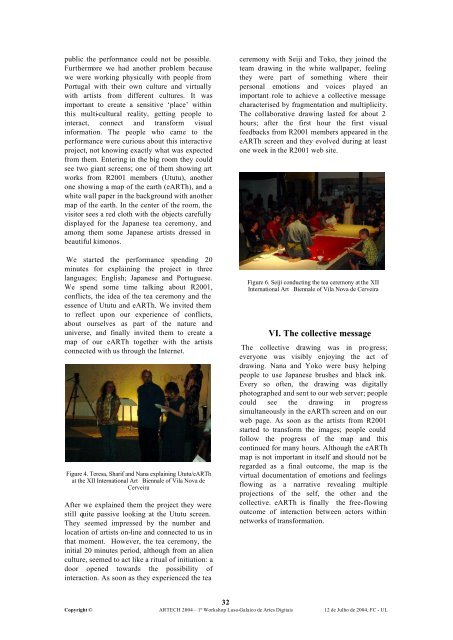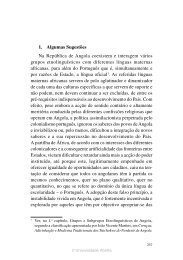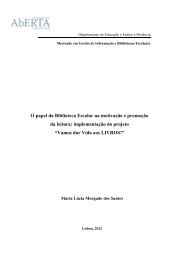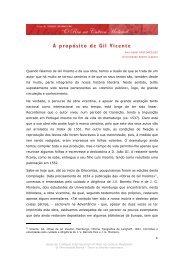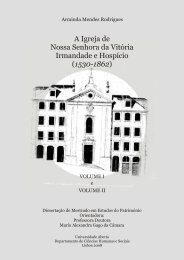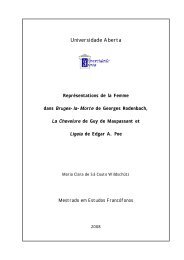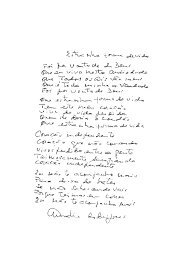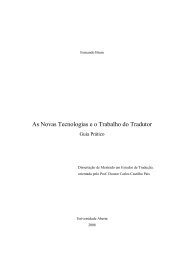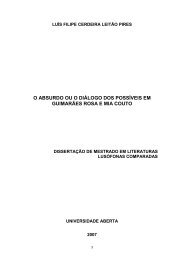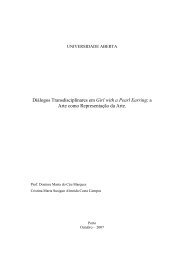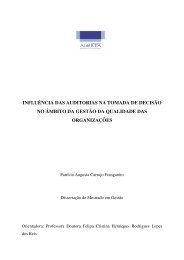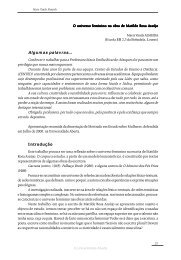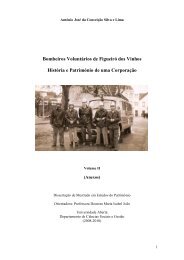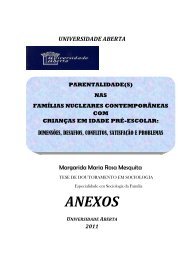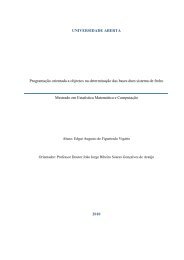NA SENDA DA IMAGEM A Representação ea Tecnologia na Arte
NA SENDA DA IMAGEM A Representação ea Tecnologia na Arte
NA SENDA DA IMAGEM A Representação ea Tecnologia na Arte
Create successful ePaper yourself
Turn your PDF publications into a flip-book with our unique Google optimized e-Paper software.
public the performance could not be possible.<br />
Furthermore we had another problem because<br />
we were working physically with people from<br />
Portugal with their own culture and virtually<br />
with artists from different cultures. It was<br />
important to cr<strong>ea</strong>te a sensitive ‘place’ within<br />
this multi-cultural r<strong>ea</strong>lity, getting people to<br />
interact, connect and transform visual<br />
information. The people who came to the<br />
performance were curious about this interactive<br />
project, not knowing exactly what was expected<br />
from them. Entering in the big room they could<br />
see two giant screens; one of them showing art<br />
works from R2001 members (Ututu), another<br />
one showing a map of the <strong>ea</strong>rth (eARTh), and a<br />
white wall paper in the background with another<br />
map of the <strong>ea</strong>rth. In the center of the room, the<br />
visitor sees a red cloth with the objects carefully<br />
displayed for the Japanese t<strong>ea</strong> ceremony, and<br />
among them some Japanese artists dressed in<br />
b<strong>ea</strong>utiful kimonos.<br />
We started the performance spending 20<br />
minutes for explaining the project in three<br />
languages; English; Japanese and Portuguese.<br />
We spend some time talking about R2001,<br />
conflicts, the id<strong>ea</strong> of the t<strong>ea</strong> ceremony and the<br />
essence of Ututu and eARTh. We invited them<br />
to reflect upon our experience of conflicts,<br />
about ourselves as part of the <strong>na</strong>ture and<br />
universe, and fi<strong>na</strong>lly invited them to cr<strong>ea</strong>te a<br />
map of our eARTh together with the artists<br />
connected with us through the Internet.<br />
Figure 4. Teresa, Sharif and Na<strong>na</strong> explaining Ututu/eARTh<br />
at the XII Inter<strong>na</strong>tio<strong>na</strong>l Art Bien<strong>na</strong>le of Vila Nova de<br />
Cerveira<br />
After we explained them the project they were<br />
still quite passive looking at the Ututu screen.<br />
They seemed impressed by the number and<br />
location of artists on-line and connected to us in<br />
that moment. However, the t<strong>ea</strong> ceremony, the<br />
initial 20 minutes period, although from an alien<br />
culture, seemed to act like a ritual of initiation: a<br />
door opened towards the possibility of<br />
interaction. As soon as they experienced the t<strong>ea</strong><br />
ceremony with Seiji and Toko, they joined the<br />
t<strong>ea</strong>m drawing in the white wallpaper, feeling<br />
they were part of something where their<br />
perso<strong>na</strong>l emotions and voices played an<br />
important role to achieve a collective message<br />
characterised by fragmentation and multiplicity.<br />
The collaborative drawing lasted for about 2<br />
hours; after the first hour the first visual<br />
feedbacks from R2001 members app<strong>ea</strong>red in the<br />
eARTh screen and they evolved during at l<strong>ea</strong>st<br />
one week in the R2001 web site.<br />
Figure 6. Seiji conducting the t<strong>ea</strong> ceremony at the XII<br />
Inter<strong>na</strong>tio<strong>na</strong>l Art Bien<strong>na</strong>le of Vila Nova de Cerveira<br />
VI. The collective message<br />
The collective drawing was in progress;<br />
everyone was visibly enjoying the act of<br />
drawing. Na<strong>na</strong> and Yoko were busy helping<br />
people to use Japanese brushes and black ink.<br />
Every so often, the drawing was digitally<br />
photographed and sent to our web server; people<br />
could see the drawing in progress<br />
simultaneously in the eARTh screen and on our<br />
web page. As soon as the artists from R2001<br />
started to transform the images; people could<br />
follow the progress of the map and this<br />
continued for many hours. Although the eARTh<br />
map is not important in itself and should not be<br />
regarded as a fi<strong>na</strong>l outcome, the map is the<br />
virtual documentation of emotions and feelings<br />
flowing as a <strong>na</strong>rrative rev<strong>ea</strong>ling multiple<br />
projections of the self, the other and the<br />
collective. eARTh is fi<strong>na</strong>lly the free-flowing<br />
outcome of interaction between actors within<br />
networks of transformation.<br />
32<br />
Copyright © ARTECH 2004 – 1º Workshop Luso-Galaico de <strong>Arte</strong>s Digitais 12 de Julho de 2004, FC - UL


